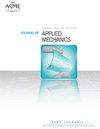Axial crushing behaviors of metal density gradient foam-filled square taper tubes: Analytical model and numerical calculation
IF 2.8
4区 工程技术
Q2 MECHANICS
引用次数: 0
Abstract
Metal tube is a traditional energy-absorbing structure, and metal foam is a lightweight material with advantages, i.e. high energy absorption and high specific strength. The foam-filled square tube can improve the crashworthiness and has better energy absorption, which is higher than the sum of the energy absorption of the tube and foam. Axial crushing behaviors of metal density gradient foam (DGF) filled square taper tubes are studied analytically and numerically in this paper. An analytical model is presented to study the crushing behavior of DGF filled square taper metal tube under axial loading, in which the interaction between square taper tube and DGF is considered. The numerical calculation is conducted, and the deformation mode is obtained. The analytical predictions are well consistent with the experimental and numerical results. The influences of taper angle, foam strength, maximum relative density and minimum relative density of gradient foam on the compressive behavior of metal DGF filled square taper tube under axial loading are considered. It is demonstrated that when the taper angle is less than 85°, the average crushing force increases as the minimum density of the DGF increases. However, when the taper angle is greater than 85°, the average crushing force decreases with the increase of the minimum density of gradient. This proposed analytical model can effectively predict the axial crushing behaviors of metal DGF filled square taper tube.金属密度梯度泡沫填充方锥管轴向破碎行为:解析模型与数值计算
金属管是传统的吸能结构,金属泡沫是一种轻质材料,具有吸能高、比强度高等优点。填充泡沫的方管可以提高耐撞性,并且具有较好的吸能性,比填充泡沫的方管和泡沫的吸能之和要高。本文对金属密度梯度泡沫(DGF)填充方锥管的轴向破碎行为进行了分析和数值研究。建立了考虑DGF与方锥管相互作用的轴向载荷作用下填充DGF的方锥金属管破碎特性分析模型。进行了数值计算,得到了变形模态。分析预测结果与实验和数值结果吻合较好。考虑了轴向载荷作用下,锥形角、泡沫强度、梯度泡沫的最大相对密度和最小相对密度对金属DGF填充方锥管压缩性能的影响。结果表明,当锥角小于85°时,平均破碎力随着DGF最小密度的增大而增大。而当锥角大于85°时,平均破碎力随最小梯度密度的增大而减小。该分析模型可以有效地预测金属DGF填充方锥管的轴向破碎行为。
本文章由计算机程序翻译,如有差异,请以英文原文为准。
求助全文
约1分钟内获得全文
求助全文
来源期刊
CiteScore
4.80
自引率
3.80%
发文量
95
审稿时长
5.8 months
期刊介绍:
All areas of theoretical and applied mechanics including, but not limited to: Aerodynamics; Aeroelasticity; Biomechanics; Boundary layers; Composite materials; Computational mechanics; Constitutive modeling of materials; Dynamics; Elasticity; Experimental mechanics; Flow and fracture; Heat transport in fluid flows; Hydraulics; Impact; Internal flow; Mechanical properties of materials; Mechanics of shocks; Micromechanics; Nanomechanics; Plasticity; Stress analysis; Structures; Thermodynamics of materials and in flowing fluids; Thermo-mechanics; Turbulence; Vibration; Wave propagation

 求助内容:
求助内容: 应助结果提醒方式:
应助结果提醒方式:


